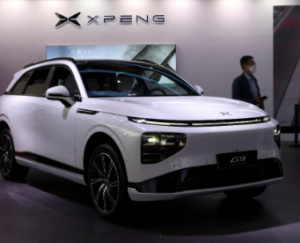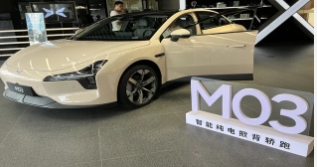Keywords: Xpeng, electric vehicles, Mona brand, mass-market EV, Tesla, China automotive market, artificial intelligence, share buyback, stock performance, EV competition.
Affordable Pricing Strategy
Xpeng’s new Mona brand is set to make waves in the EV market with its aggressive pricing strategy. The Mona M03 electric coupe, the first model under this brand, has a starting price of just $16,812, significantly lower than Tesla’s Model 3, which starts at a much higher price point. This competitive pricing is expected to attract a broader consumer base, particularly in price-sensitive markets.
The market’s enthusiasm for the new model was evident almost immediately after its launch. Xpeng reported that orders for the Mona M03 exceeded 10,000 within just 52 minutes of the car’s formal launch event in Beijing. This rapid surge in demand highlights the strong market potential for affordable EVs in China and reinforces Xpeng’s strategic focus on the mass market.
Strategic Investments and Market Position
Xpeng’s founder and CEO, He Xiaopeng, has emphasized that the company’s next decade will focus on the integration of artificial intelligence (AI) into its vehicles, positioning Xpeng at the forefront of smart EV technology. This long-term vision aims to differentiate Xpeng from its competitors by offering not just affordable EVs but also technologically advanced vehicles that appeal to tech-savvy consumers.
In a further display of confidence in the company, He Xiaopeng recently purchased over 1 million shares each of Xpeng’s stock traded in the U.S. and Hong Kong, with a total U.S. purchase valued at nearly $10 million. This move has bolstered investor confidence, even as Xpeng’s shares have struggled, losing more than 45% of their value so far this year.
Broader Impact on the EV Market
Xpeng’s launch of an affordable mass-market EV underscores China’s growing dominance in the global automotive manufacturing industry. According to Michael Dunne, founder and CEO of Dunne Insights, “China can produce cars more cheaply than anyone else in the world,” further solidifying its position as the world center for automotive production.

The launch also comes at a time of mixed performance among other Chinese EV companies. While Xpeng’s shares surged, Tesla’s stock fell nearly 2% on Tuesday, and shares of other Chinese EV makers such as Zeekr and Li Auto saw gains, while Nio’s shares closed slightly lower.
Challenges Ahead
Despite the positive reception to the Mona launch, Xpeng still faces significant challenges. The company’s shares remain down over 45% for the year, reflecting broader concerns about the Chinese economy and increased competition in the EV market. The success of the Mona brand will be crucial in determining whether Xpeng can reverse its fortunes and regain investor confidence.
The launch of the Mona M03 is a bold move that could potentially reshape the competitive landscape of the EV market, particularly in China. By offering an affordable yet feature-rich electric vehicle, Xpeng is positioning itself to capture a significant share of the growing mass-market segment, a strategy that could pay off handsomely if the Mona brand resonates with consumers as strongly as the initial sales figures suggest.
Keywords: Xpeng, electric vehicles, Mona brand, mass-market EV, Tesla, China automotive market, artificial intelligence, share buyback, stock performance, EV competition.
1. Xpeng’s Market Position and Performance
Historical Stock Performance: Provide a comparison of Xpeng’s stock performance over the past year. Highlight key events that have influenced its share price, such as previous product launches, financial results, or broader market conditions.
Comparison with Competitors: Include data comparing Xpeng’s market share, sales, and stock performance with other Chinese EV makers like Nio, Li Auto, and international competitors like Tesla. This can give readers a better understanding of Xpeng’s position in the competitive landscape.
2. Sales and Market Penetration
Sales Projections: Offer data on sales projections for the Mona M03, both in terms of initial orders and long-term expectations. Include estimates from industry analysts or Xpeng’s own forecasts.
Market Penetration: Provide data on Xpeng’s market penetration in different regions, particularly focusing on its presence in China’s smaller cities and rural areas where the demand for affordable EVs is growing.
3. Financial Health of Xpeng
Revenue and Profit Trends: Include recent data on Xpeng’s revenue, net income, and profit margins. Highlight how these figures have trended over the last few quarters and how they compare to analyst expectations.
Cash Reserves and R&D Investments: Provide data on Xpeng’s current cash reserves and how much it is investing in research and development (R&D), particularly in AI and autonomous driving technologies.
4. Xpeng’s Strategic Focus on AI and Technology
AI Integration in Vehicles: Offer more detailed data on Xpeng’s plans to integrate AI into its vehicles. This could include information on partnerships with tech companies, patents filed, or specific AI features that differentiate Xpeng vehicles from competitors.
Autonomous Driving Capabilities: Provide data on Xpeng’s progress in autonomous driving, including any milestones achieved, regulatory approvals, or comparisons with Tesla’s Autopilot or Full Self-Driving features.
5. Consumer Demand and Preferences
Consumer Survey Data: Include data from consumer surveys or studies that show what features or price points are most attractive to buyers in the EV market. Highlight how the Mona M03 meets these demands.
Demographic Insights: Provide data on the demographic profile of Xpeng’s customers, particularly those interested in the Mona M03. This could include age, income levels, urban vs. rural distribution, etc.
6. Impact on the Global EV Market
Global EV Market Trends: Offer data on the global EV market, including growth rates, sales figures, and how Xpeng’s pricing strategy might influence other markets outside China.
Supply Chain and Manufacturing Data: Provide insights into how Xpeng’s ability to produce affordable EVs is linked to its supply chain, manufacturing efficiency, and relationships with suppliers.
7. Regulatory Environment and Government Support
Government Incentives: Include data on government incentives in China for EV buyers, such as subsidies, tax breaks, or charging infrastructure development. Highlight how these incentives support Xpeng’s sales strategy.
Regulatory Compliance: Provide data on Xpeng’s compliance with environmental regulations, safety standards, and any certifications or approvals received that might influence consumer confidence.
8. Market Reactions and Analyst Opinions
Analyst Ratings: Include current analyst ratings for Xpeng. How many analysts rate it as a “Buy,” “Hold,” or “Sell”? Include any recent upgrades or downgrades following the Mona launch.
Investor Sentiment: Provide data on how institutional investors are reacting to Xpeng’s strategy. This could include recent buying or selling activity, changes in shareholding patterns, or commentary from major funds.

9. Technical Analysis of Xpeng Stock
Support and Resistance Levels: Include data on key technical indicators for Xpeng’s stock, such as support and resistance levels, moving averages, and relative strength index (RSI). This could give readers insights into potential future price movements.
Trading Volume: Provide data on trading volume around the time of the Mona launch and any significant price movements. High volume could indicate strong market interest or significant moves by large investors.
10. Future Growth Prospects and Expansion Plans
International Expansion: Provide data on Xpeng’s plans for international expansion. This could include potential new markets, partnerships, or distribution networks being developed outside China.
Long-Term Strategic Goals: Offer data on Xpeng’s long-term goals, such as sales targets for the Mona brand, planned launches of new models, or expansion into new technologies like battery production or charging infrastructure.
11. Industry-Wide Implications
Impact on Tesla and Other EV Makers: Include data on how Xpeng’s pricing strategy might impact other EV makers, particularly Tesla. This could include potential price wars, shifts in market share, or changes in consumer preferences.
Supply Chain Implications: Discuss how Xpeng’s ability to offer lower prices might influence the global EV supply chain, including potential impacts on battery suppliers, component manufacturers, and logistics providers.





